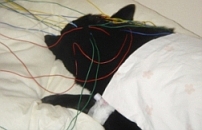Epilepsy
 Kuva julkaistu koiran omistajan suostumuksella |
Epilepsy is the most common neurological disorder in dogs. It can be caused by genetic or non-genetic factors, such as tumours, trauma, infections, or metabolic conditions. Genetic epilepsy is reported in almost all dog breeds. In some breeds, epilepsy is very common: the prevalence can be up to 20 % in particular breeds.
The most typical symptoms of genetic, or idiopathic, epilepsy are recurrent tonic-clonic seizures or so-called absence seizures in which the level of consciousness is temporarily decreased. Epileptic seizures are typically short and self-limited, with duration of a couple of minutes. Sometimes in severe cases the seizure duration is longer, and medical intervention is required to stop it.
Epileptic seizures are caused by abnormal electrochemical activity of the brain. Focal, or partial, epileptic activity in the brain can lead to seizure signs restricted only to a certain body part, for example twitching or cramping of one limb only. In case epileptic activity spreads to involve both hemispheres of the brain, signs of epileptic seizure can be seen in both body sides, and consciousness is impaired.
The onset of genetic/idiopathic epilepsy is typically at ½-5 years of age, but also younger and older dogs can become affected. The disease is diagnosed by so-called exclusion diagnostics: in case no other cause, such as a disease of the brain or metabolism, is found for the recurrent seizures, the diagnosis of epilepsy is supported.
In many breeds, epilepsy is an inherited disease with an unknown mode of inheritance. There may be several genetic risk factors underlying the disease. In some breeds, epilepsy is caused by one gene, and follows an autosomal recessive mode of inheritance. For example, benign juveline epilepsy identified in the Lagotto Romagnolo breed is inherited in an autosomal recessive manner, and is caused by a mutation in the LGI2 gene. A genetic test has been developed for this disease. Benign juvenile epilepsies are, however, rarely reported in dogs, and epilepsy caused by the LGI2 mutation has only been found in Lagotto Romagnolos.
Adult-onset genetic epilepsy is relatively common among Belgian Shepherds, and there is evidence that genes play a major role in the disease risk. Disease-risk conferring variants have been identified in the ADAM23 gene. The risk variants are common also among healthy dogs. Other genetic or environmental factors may be involved in the disease risk.
Study breeds:
All dog breeds can participate in the research. Our priority is in breeds in which epilepsy is considered a severe and/or common health problem. Currently, we have active projects ongoing in Australian Shepherds, Barbets, Beagles, Belgian Shepherds, Border Collies, Border Terriers, Finnish Lapphunds, Finnish Spitzes, Irish Setters, Kromfohrländers, Labrador Retrievers, Miniature Pinschers, Norwich Terriers, Pyrenean Shepherds, Schipperkes, and Whippets.
Dogs eligible for study::
We collect samples from dogs with epilepsy, and healthy old dogs with age more than 7 years.
Copies of diagnoses and other information needed:
Seizure diary, results from clinical examinations, possible post-mortem report.
Links:
Further information on sending blood samples.
A sample form to be sent along with the blood samples.
An electronic form for details and updates of dog's health and owner's contact information.
We collect epilepsy questionnaires from all sampled epilepsy-affected dogs. Please download it from this web page, fill it out and send to us by e-mail.
Contact person:
Tiina Heinonen (tiina.heinonen(at)helsinki.fi).
Literature:
Jokinen ym. Benign familial juvenile epilepsy in Lagotto Romagnolo dogs. J Vet Intern Med. 2007 May-Jun;21(3):464-71.
Seppälä ym. LGI2 truncation causes a remitting focal epilepsy in dogs. PLoS Genet. 2011 Jul;7(7):e1002194
Seppälä ym. Identification of a novel idiopathic epilepsy locus in Belgian Shepherd dogs. PLoS One. 2012;7(3):e33549.